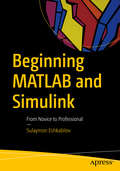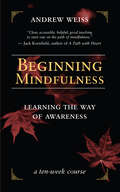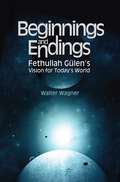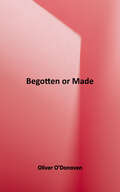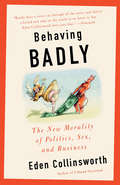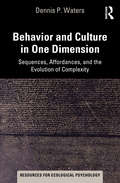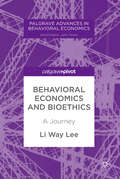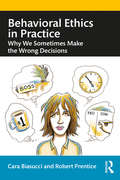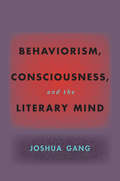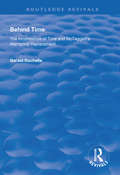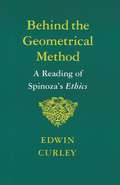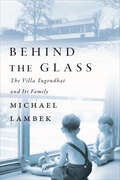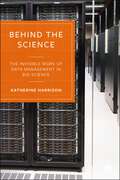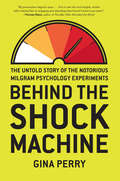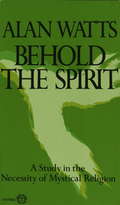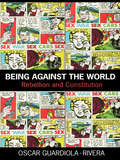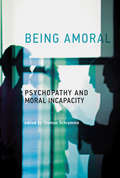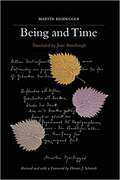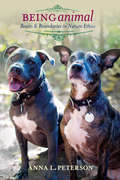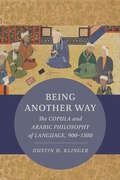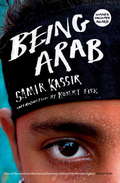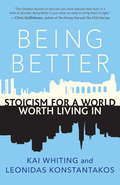- Table View
- List View
Beginning MATLAB and Simulink: From Novice to Professional
by Sulaymon EshkabilovEmploy essential and hands-on tools and functions of the MATLAB and Simulink packages, which are explained and demonstrated via interactive examples and case studies. This book contains dozens of simulation models and solved problems via m-files/scripts and Simulink models which help you to learn programming and modeling essentials. You’ll become efficient with many of the built-in tools and functions of MATLAB/Simulink while solving engineering and scientific computing problems. Beginning MATLAB and Simulink explains various practical issues of programming and modelling in parallel by comparing MATLAB and Simulink. After reading and using this book, you'll be proficient at using MATLAB and applying the source code from the book's examples as templates for your own projects in data science or engineering. What You Will LearnGet started using MATLAB and SimulinkCarry out data visualization with MATLABGain the programming and modeling essentials of MATLABBuild a GUI with MATLABWork with integration and numerical root finding methodsApply MATLAB to differential equations-based models and simulationsUse MATLAB for data science projectsWho This Book Is ForEngineers, programmers, data scientists, and students majoring in engineering and scientific computing.
Beginning Mindfulness: Learning the Way of Awareness
by Andrew WeissA Simple Manual That Really Works Knowing that most people do not stop their lives to engage in spiritual practice, Buddhist teacher Andrew Weiss has always taught the direct application of practice to daily life. While also teaching sitting and walking meditation, he emphasizes mindfulness — the practice of seeing every action as an opportunity to awaken meditative inquiry. Over the years, Andrew has honed his teachings into an effective ten-week course with progressive steps and home-play assignments. Beginning Mindfulness is intended for anyone practicing in daily life without the luxury of long meditation retreats. Weiss skillfully blends the traditions of his teachers into an easy and humorous program of learning the Buddhist art of mindfulness.
Beginning with the Pre-Socratics
by Merrill RingDesigned to provide non-philosophy majors in a history of philosophy course with a simple background to the earliest Greek philosophers, this text includes a brief history of the region, followed by chapters on Greek cosmology, and the earliest rational philosophers, such as Miletus and Thales.
Beginnings and Endings: Fethullah Gulen's Vision for Today's World
by Walter H. WagnerWalter Wagner attempts to present a framework of understanding that outlines the philosophy and theology of Fethullah Gulen, a worldwide known scholar of Islam who inspired a global movement of education and interfaith dialogue. This book shows how Gülen's vision for the present and future makes the present and future forms of Hizmet an essential part of his wider and urgent call for the formation of a community of religiously committed and non-religiously committed persons to work toward a just, equitable and prosperous world now.
Begotten or Made?
by Oliver O'DonovanHow is it that we have so lost sight of the meaning of the human person that our very biological sex is seen as just another medical problem to be solved by technique? In a society that has rejected all moral norms, that refuses to honor God as Creator, what hope do we have of stemming the tide of scientific intervention into even the most sacred dimensions of our humanity? In this prescient volume, originally published in 1984, the eminent theological ethicist Oliver O’Donovan offers a penetrating analysis of our confusion over human nature and the proper boundaries of medical science. <p><p> O’Donovan exposes the assumptions that underlie new technologies that presume to “make” human life, and offers Christians the philosophical clarity they need to navigate the torrent of increasingly baffling ethical questions they face. <p><p> Today we need this wisdom more than ever, which is why the Davenant Institute is proud to be publishing this affordable new edition for the 21st century, complete with a new introduction by Matthew Lee Anderson and a retrospective by the author.
Behaving Badly: The New Morality in Politics, Sex, and Business
by Eden CollinsworthWhat is the relevance of morality today? Eden Collinsworth enlists the famous, the infamous, and the heretofore unheard-of to unravel how we make moral choices in an increasingly complex—and ethically flexible—age. To call these unsettling times is an understatement: our political leaders are less and less respectable; in the realm of business, cheating, lying, and stealing are hazily defined; and in daily life, rapidly changing technology offers permission to act in ways inconceivable without it. Yet somehow, this hasn’t quite led to a complete free-for-all—people still draw lines around what is acceptable and what is not. Collinsworth sets out to understand how and why. In her intrepid quest, she squares off with a prime minister, the editor of London’s Financial Times, a holocaust survivor, a pop star, and a former commander of the U.S. Air Force to grapple with the impracticality of applying morals to foreign policy; precisely when morality gets lost in the making of money; what happens to morality without free will; whether “immoral” women are just those having a better time; why celebrities have become the new moral standard-bearers; and if testosterone is morality’s enemy or its hero.
Behavior and Culture in One Dimension: Sequences, Affordances, and the Evolution of Complexity (Resources for Ecological Psychology Series)
by Dennis P. WatersBehavior and Culture in One Dimension adopts a broad interdisciplinary approach, presenting a unified theory of sequences and their functions and an overview of how they underpin the evolution of complexity. Sequences of DNA guide the functioning of the living world, sequences of speech and writing choreograph the intricacies of human culture, and sequences of code oversee the operation of our literate technological civilization. These linear patterns function under their own rules, which have never been fully explored. It is time for them to get their due. This book explores the one-dimensional sequences that orchestrate the structure and behavior of our three-dimensional habitat. Using Gibsonian concepts of perception, action, and affordances, as well as the works of Howard Pattee, the book examines the role of sequences in the human behavioral and cultural world of speech, writing, and mathematics. The book offers a Darwinian framework for understanding human cultural evolution and locates the two major informational transitions in the origins of life and civilization. It will be of interest to students and researchers in ecological psychology, linguistics, cognitive science, and the social and biological sciences.
Behavior and Culture in One Dimension: Sequences, Affordances, and the Evolution of Complexity (Resources for Ecological Psychology Series)
by Dennis WatersBehavior and Culture in One Dimension adopts a broad interdisciplinary approach, presenting a unified theory of sequences and their functions and an overview of how they underpin the evolution of complexity.Sequences of DNA guide the functioning of the living world, sequences of speech and writing choreograph the intricacies of human culture, and sequences of code oversee the operation of our literate technological civilization. These linear patterns function under their own rules, which have never been fully explored. It is time for them to get their due. This book explores the one-dimensional sequences that orchestrate the structure and behavior of our three-dimensional habitat. Using Gibsonian concepts of perception, action, and affordances, as well as the works of Howard Pattee, the book examines the role of sequences in the human behavioral and cultural world of speech, writing, and mathematics. The book offers a Darwinian framework for understanding human cultural evolution and locates the two major informational transitions in the origins of life and civilization. It will be of interest to students and researchers in ecological psychology, linguistics, cognitive science, and the social and biological sciences.
Behavioral Economics and Bioethics: A Journey (Palgrave Advances In Behavioral Economics Ser.)
by Li Way LeeThis book takes readers on a journey through the wide universe of bioethics, raising the following question: what is the proper attitude towards health, life, and death from the perspective of contemporary behavioral economics? Drawing on fields as diverse as economics, ethics, ecology, biology, and philosophy, this book seeks to uncover the bioethics we accomplish, not the moral principles that we advocate. This book covers life-and-death issues arranged around five themes: selves, persons, populations, species, and “Future Earth”. Ultimately, the author illustrates two kinds of justice: static and dynamic. Static justice prevails whenever parties are free to bargain with each other, while dynamic justice follows from parties' interactions over time. An examination into these types of justice reveals one particularly striking phenomenon: attempts by others to tip the balance of justice have a tendency to backfire. Of primary interest to behavioral economists, this book will also appeal to scholars studying bioethics, ecology, medicine, and philosophy, as well as all people dealing with issues of health, dying, and death.
Behavioral Ethics in Practice: Why We Sometimes Make the Wrong Decisions
by Cara Biasucci Robert PrenticeThis book is an accessible, research-based introduction to behavioral ethics. Often ethics education is incomplete because it ignores how and why people make moral decisions. But using exciting new research from fields such as behavioural psychology, cognitive science, and evolutionary biology, the study of behavioural ethics uncovers the common reasons why good people often screw up. Scientists have long studied the ways human beings make decisions, but only recently have researchers begun to focus specifically on ethical decision making. Unlike philosophy and religion, which aim to tell people how to think and act about various moral issues, behavioral ethics research reveals the factors that influence how people really make moral decisions. Most people get into ethical trouble for doing obviously wrong things. Aristotle cannot help, but learning about behavioral ethics can. By supplementing traditional approaches to teaching ethics with a clear, detailed, research-based introduction to behavioral ethics, beginners can quickly become familiar with the important elements of this new field. This book includes the bonus of being coordinated with Ethics Unwrapped – a free, online, educational resource featuring award-winning videos and teaching materials on a variety of behavioral ethics (and general ethics) topics. This book is a useful supplement for virtually every ethics course, and important in any course where incorporating practical ethics in an engaging manner is paramount. The content applies to every discipline –business ethics, journalism, medicine, legal ethics, and others – because its chief subject is the nature of moral decision making. The book is also highly relevant to practitioners across all sectors.
Behaviorism, Consciousness, and the Literary Mind (Hopkins Studies in Modernism)
by Joshua GangWhat might behaviorism, that debunked school of psychology, tell us about literature?If inanimate objects such as novels or poems have no mental properties of their own, then why do we talk about them as if they do? Why do we perceive the minds of characters, narrators, and speakers as if they were comparable to our own? In Behaviorism, Consciousness, and the Literary Mind, Joshua Gang offers a radical new approach to these questions, which are among the most challenging philosophical problems faced by literary study today.Recent cognitive criticism has tried to answer these questions by looking for similarities and analogies between literary form and the processes of the brain. In contrast, Gang turns to one of the twentieth century's most infamous psychological doctrines: behaviorism. Beginning in 1913, a range of psychologists and philosophers—including John B. Watson, B. F. Skinner, and Gilbert Ryle—argued that many of the things we talk about as mental phenomena aren't at all interior but rather misunderstood behaviors and physiological processes. Today, behaviorism has relatively little scientific value, but Gang argues for its enormous critical value for thinking about why language is so good at creating illusions of mental life.Turning to behaviorism's own literary history, Gang offers the first sustained examination of the outmoded science's place in twentieth-century literature and criticism. Through innovative readings of figures such as I. A. Richards, the American New Critics, Samuel Beckett, Harold Pinter, and J. M. Coetzee, Behaviorism, Consciousness, and the Literary Mind reveals important convergences between modernist writers, experimental psychology, and analytic philosophy of mind—while also giving readers a new framework for thinking about some of literature's most fundamental and exciting questions.
Behind Palace Doors: Marriage and Divorce in the House of Windsor
by Nigel Dempster Peter Evans"For three decades, Nigel Dempster, London's top gossip columnist, has chronicled Britain's royal family and been the confidant of several of its members. While others have speculated about the royals' loves and liaisons, their marriages, divorces, and remarriages, Dempster has heard the truth from some of the most highly placed sources in Britain. In Behind Palace Doors, he and investigative journalist Peter Evans present a through-the-keyhole story of the marital woes of the Windsors and their most celebrated members, Prince Charles and Princess Diana." "Behind Palace Doors is an astonishing anatomy of what went wrong and where it will end. The union of Charles and Diana, the authors reveal, was doomed from the start. Soon after the engagement, Charles told his parents he had made a "bloody awful" mistake, and begged to be released, but to no avail. As the marriage faltered, he returned to an old love, Camilla Parker Bowles, whose own husband was philandering. Caught in this sorrowful triangle, Diana changed from naive young girl to angry, vengeful wife. But the major reason the marriage fell apart, we learn, was not Camilla, or even Diana's own relationships with other men, but Diana's destructive tantrums and deep hereditary depressions. In less than two years' time, Dempster has learned, she will liberate herself from the Prince of Wales and his family." "As for Charles's brother Andrew, his marriage to Sarah Ferguson fared no better. Five months pregnant with their second child, she began a close friendship with Texan Steve Wyatt, and later she kept steady company with her "financial advisor" John Bryan. The authors provide the reasons for Sarah's reckless behavior and explain why Andrew remained tolerant for so long." "In this intimate, anecdotal book, Dempster and Evans take the reader inside the private family meeting called to handle the crisis surrounding the "Camillagate" tapes. The authors present the reactions - including actual comments - of the Queen and Prince Philip, the manipulations of the Queen Mother, and the acid recriminations of Princess Anne. They also divulge the wrenching trauma of the Parker Bowles family and describe an extraordinary scene in which Camilla's father dresses down the Prince of Wales." "Revealing, at times even shocking, Behind Palace Doors is nonetheless surprisingly sympathetic. The authors portray the British royals as spoiled, selfish, frequently wanton, yet in the end, supremely human."--BOOK JACKET. Title Summary field provided by Blackwell North America, Inc. All Rights Reserved
Behind Time: Incoherence of Time and McTaggart's Atemporal Replacement (Routledge Revivals)
by Gerald RochelleFirst published in 1998, this volume responded to and evaluated criticisms of McTaggart’s atemporal philosophy of time. Established philosophical positions on time had positioned themselves in relation to either the A Series (past, present and future) or the B Series (earlier and later). McTaggart considered both series untenable and proposed his own, atemporal C Series. Beginning with an overview of McTaggart’s position, Gerald Rochelle attempts to reinforce the seriousness of, and think beyond, McTaggart’s attempt to describe a world without time through an assessment of McTaggart’s criticisms and his suggested alternative. Rochelle argues that McTaggart’s atemporal world constitutes a strong foundation for a new theory on time which breaks away from the existing philosophical models of temporality.
Behind the Geometrical Method: A Reading of Spinoza's Ethics
by Edwin CurleyThis book is the fruit of twenty-five years of study of Spinoza by the editor and translator of a new and widely acclaimed edition of Spinoza's collected works. Based on three lectures delivered at the Hebrew University of Jerusalem in 1984, the work provides a useful focal point for continued discussion of the relationship between Descartes and Spinoza, while also serving as a readable and relatively brief but substantial introduction to the Ethics for students. Behind the Geometrical Method is actually two books in one. The first is Edwin Curley's text, which explains Spinoza's masterwork to readers who have little background in philosophy. This text will prove a boon to those who have tried to read the Ethics, but have been baffled by the geometrical style in which it is written. Here Professor Curley undertakes to show how the central claims of the Ethics arose out of critical reflection on the philosophies of Spinoza's two great predecessors, Descartes and Hobbes. The second book, whose argument is conducted in the notes to the text, attempts to support further the often controversial interpretations offered in the text and to carry on a dialogue with recent commentators on Spinoza. The author aligns himself with those who interpret Spinoza naturalistically and materialistically.
Behind the Glass: The Villa Tugendhat and Its Family
by Michael LambekThe Villa Tugendhat, designed by Mies van der Rohe in 1928, is an icon of architectural modernism and a UNESCO World Heritage site. Behind the Glass tells the true story of the large family connected to it, who rose to prominence through industrial textile manufacturing. The book traces the transformations in the life of the family, from their roots in a Jewish ghetto to part of the wealthy bourgeoisie in the Austro-Hungarian Empire to adaptation in interwar independent Czechoslovakia and flight in the face of Nazi invasion. Michael Lambek examines the generation born in the first decade of the twentieth century, especially Grete Tugendhat – Lambek’s maternal grandmother – who commissioned, inhabited, championed, and relinquished the distinctive modern house. An exploration of life in and surrounding the Villa Tugendhat offers a factual portrait that runs counter to the fictional one portrayed in Simon Mawer’s The Glass Room. The book also provides unpublished correspondence between Martin Heidegger and Ernst Tugendhat, Grete’s son, as well as a description of the impact of a 2017 family reunion. Behind the Glass reflects on the meaning of a "family" and suggests that it is more than a nuclear household – a family reproduces itself over generations, a product of how it represents itself and is represented by others.
Behind the Science: The Invisible Work of Data Management in Big Science
by Katherine HarrisonAvailable Open Access digitally under CC-BY-NC-ND licence. Some of the largest quantities of data produced today occur as the result of experiments taking place at Big Science facilities. This book tells the story of a unique research journey following the people responsible for designing and implementing data management at a new Big Science facility, the European Spallation Source (ESS) in Lund, Sweden. It critically examines the idea of data as an absolute ‘truth’ and sheds light on the often underestimated, yet essential, contributions of these data experts. Providing a unique glimpse into the inner workings of Big Science, this book fills an important gap in science and technology studies and critical data studies.
Behind the Shock Machine
by Gina PerryWhen social psychologist Stanley Milgram invited volunteers to take part in an experiment at Yale in the summer of 1961, none of the participants could have foreseen the worldwide sensation that the published results would cause. Milgram reported that fully 65 percent of the volunteers had repeatedly administered electric shocks of increasing strength to a man they believed to be in severe pain, even suffering a life-threatening heart condition, simply because an authority figure had told them to do so. Such behavior was linked to atrocities committed by ordinary people under the Nazi regime and immediately gripped the public imagination. The experiments remain a source of controversy and fascination more than fifty years later.In Behind the Shock Machine, psychologist and author Gina Perry unearths for the first time the full story of this controversial experiment and its startling repercussions. Interviewing the original participants--many of whom remain haunted to this day about what they did--and delving deep into Milgram's personal archive, she pieces together a more complex picture and much more troubling picture of these experiments than was originally presented by Milgram. Uncovering the details of the experiments leads her to question the validity of that 65 percent statistic and the claims that it revealed something essential about human nature. Fleshed out with dramatic transcripts of the tests themselves, the book puts a human face on the unwitting people who faced the moral test of the shock machine and offers a gripping, unforgettable tale of one man's ambition and an experiment that defined a generation.
Behold the Spirit: A Study in the Necessity of Mystical Religion
by Alan W. WattsThis study of the necessity of mystical religion, also shows how traditional Western doctrine can be reconciled with the intuitive religion of the Orient.From the Trade Paperback edition.
Being Against the World: Rebellion and Constitution (Birkbeck Law Press)
by Oscar Guardiola-RiveraHow can we save politics from the politician? How can we save ourselves? This book looks at the example of those who leave the city and break the social contract, rebellious exiles and freedom fighters escaping the wheel of necessity, and learns from them.
Being Amoral: Psychopathy and Moral Incapacity (Philosophical Psychopathology)
by Thomas SchrammeInvestigations of specific moral dysfunctions or deficits that shed light on the capacities required for moral agency. Psychopathy has been the subject of investigations in both philosophy and psychiatry and yet the conceptual issues remain largely unresolved. This volume approaches psychopathy by considering the question of what psychopaths lack. The contributors investigate specific moral dysfunctions or deficits, shedding light on the capacities people need to be moral by examining cases of real people who seem to lack those capacities. The volume proceeds from the basic assumption that psychopathy is not characterized by a single deficit—for example, the lack of empathy, as some philosophers have proposed—but by a range of them. Thus contributors address specific deficits that include impairments in rationality, language, fellow-feeling, volition, evaluation, and sympathy. They also consider such issues in moral psychology as moral motivation, moral emotions, and moral character; and they examine social aspects of psychopathic behavior, including ascriptions of moral responsibility, justification of moral blame, and social and legal responses to people perceived to be dangerous. As this volume demonstrates, philosophers will be better equipped to determine what they mean by “the moral point of view” when they connect debates in moral philosophy to the psychiatric notion of psychopathy, which provides some guidance on what humans need in order be able to feel the normative pull of morality. And the empirical work done by psychiatrists and researchers in psychopathy can benefit from the conceptual clarifications offered by philosophy.ContributorsGwen Adshead, Piers Benn, John Deigh, Alan Felthous, Kerrin Jacobs, Heidi Maibom, Eric Matthews, Henning Sass, Thomas Schramme, Susie Scott, David Shoemaker, Walter Sinnott-Armstrong, Matthew Talbert
Being And Time: A Revised Edition Of The Stambaugh Translation (Suny Series In Contemporary Continental Philosophy)
by Martin Heidegger Dennis J. Schmidt Joan StambaughThe publication in 1927 of Martin Heidegger’s magnum opus signaled an intellectual event of the first order and had an impact in fields far beyond that of philosophy proper. Being and Time has long been recognized as a landmark work of the twentieth century for its original analyses of the character of philosophic inquiry and the relation of the possibility of such inquiry to the human situation. Still provocative and much disputed, Heidegger’s text has been taken as the inspiration for a variety of innovative movements in fields ranging from psychoanalysis, literary theory, and existentialism to ethics, hermeneutics, and theology. A work that disturbs the traditions of philosophizing that it inherits, Being and Time raises questions about the end of philosophy and the possibilities for thinking liberated from the presumptions of metaphysics. The Stambaugh translation captures the vitality of the language and thinking animating Heidegger’s original text. It is also the most comprehensive edition insofar as it includes the marginal notes made by Heidegger in his own copy of Being and Time, and takes into account the many changes that he made in the final German edition of 1976. The revisions to the original translation correct ambiguities and problems that have become apparent since the translation first appeared. Bracketed German words have also been liberally inserted both to clarify and highlight words and connections that are difficult to translate, and to link this translation more closely to the German text. This definitive edition will serve the needs of scholars well acquainted with Heidegger’s work and of students approaching Heidegger for the first time.
Being Animal: Beasts and Boundaries in Nature Ethics (Critical Perspectives on Animals: Theory, Culture, Science, and Law)
by Anna PetersonFor most people, animals are the most significant aspects of the nonhuman world. They symbolize nature in our imaginations, in popular media and culture, and in campaigns to preserve wilderness, yet scholars habitually treat animals and the environment as mutually exclusive objects of concern. Conducting the first examination of animals' place in popular and scholarly thinking about nature, Anna L. Peterson builds a nature ethic that conceives of nonhuman animals as active subjects who are simultaneously parts of both nature and human society. Peterson explores the tensions between humans and animals, nature and culture, animals and nature, and domesticity and wildness. She uses our intimate connections with companion animals to examine nature more broadly. Companion animals are liminal creatures straddling the boundary between human society and wilderness, revealing much about the mutually constitutive relationships binding humans and nature together. Through her paradigm-shifting reflections, Peterson disrupts the artificial boundaries between two seemingly distinct categories, underscoring their fluid and continuous character.
Being Another Way: The Copula and Arabic Philosophy of Language, 900–1500 (Berkeley Series in Postclassical Islamic Scholarship #6)
by Dustin KlingerIn Being Another Way, Dustin Klinger recounts the history of how medieval Arabic philosophers in the Islamic East grappled with the logical role of the copula "to be," an ambiguity that has bedeviled Western philosophy from Parmenides to the analytic philosophers of today. Working from within a language that has no copula, a group of increasingly independent Arabic philosophers began to critically investigate the semantic role that Aristotle, for many centuries their philosophical authority, invested in the copula as the basis of his logic. Drawing on extensive manuscript research, Klinger breaks through the thicket of unstudied philosophical works to demonstrate the creativity of postclassical Islamic scholarship as it explored the consequences of its intellectual break with the past. Against the still widespread view that intellectual ferment all but disappeared during the period, he shows how these intellectuals over the centuries developed and refined a sophisticated philosophy of language that speaks to core concerns of contemporary linguistics and philosophy.
Being Arab
by Robert Fisk Samir Kassir Will HobsonIn the years before his assassination in 2005, Samir Kassir became one of Lebanon's foremost public intellectuals, a fearless critic of tyranny and an inspiring advocate of democracy. In Being Arab, his last book, he calls on the peoples of the Middle East to reject both Western double standards and Islamism in order to take the future of the region into their own hands. With the Arab Spring, millions have now answered that call.
Being Better: Stoicism for a World Worth Living In
by Kai Whiting Leonidas KonstantakosPractical answers to the urgent moral questions of our time from the ancient philosophy of Stoicism Twenty-three centuries ago, in a marketplace in Athens, Zeno of Citium, the founder of Stoicism, built his philosophy on powerful ideas that still resonate today: all human beings can become citizens of the world, regardless of their nationality, gender, or social class; happiness comes from living in harmony with nature; and, most important, humans always have the freedom to choose their attitude, even when they cannot control external circumstances. In our age of political polarization and environmental destruction, Stoicism&’s empowering message has taken on new relevance. In Being Better, Kai Whiting and Leonidas Konstantakos apply Stoic principles to contemporary issues such as social justice, climate breakdown, and the excesses of global capitalism. They show that Stoicism is not an ivory-tower philosophy or a collection of Silicon Valley life hacks but a vital way of life that helps us live simply, improve our communities, and find peace in a turbulent world.
